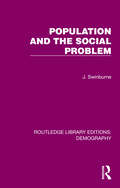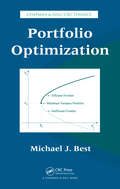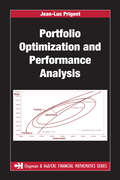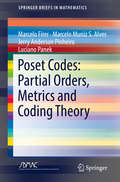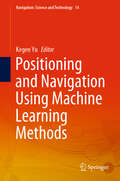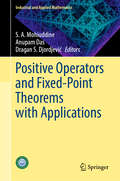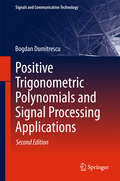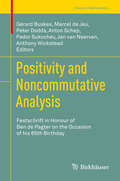- Table View
- List View
Population and the Social Problem (Routledge Library Editions: Demography #15)
by J. SwinburneOriginally published in 1924 and inevitably a product of the time in which it was published, the author assumes that people exercise their powers of reproduction near to capacity. The book views this pressure on population as a social problem, the fundamental cause of human and social challenges. Solutions such as a tax on children, public education and a laissez faire economic order are all suggested.
Population in History: Essays in Historical Demography, Volume I: General and Great Britain
by D. V. Glass D. E. C. EversleyThis large-scale comparative endeavor, complete in two volumes, reflects increasing concern with the population factor in economic and social change worldwide. Demographers, on their side, have been focusing on history. In response to this, Population in History represents the work of two practitioners that have begun to work together, using their combined approaches in an attempt to assess and account for population growth experienced by the West since the seventeenth century.There is a long record of interest in the history of population. But the interest now displayed is likely to be both more persistent and far more fruitful in its consequences. New studies have been initiated in many countries. And because the studies are more informed and systematic than many of those of earlier periods, they are already provoking the further spread of research. A much more positive part is now also being played by national and international associations of historians and demographers. It is not unlikely that, within the next fifteen or twenty years, the main outlines of population change in the seventeenth and eighteenth centuries will be firmly established for much of Europe.Previous research has tended to appear in specialist journals and academic publications. This volume is intended to provide a more easily accessible publication. It has been thought appropriate to include some earlier work, both because of its intrinsic interest and because it provided the background and part of the stimulus to the later research. Of the twenty-seven contributions to this outstanding volume, seven are unabridged reprints of earlier work; the remaining contributions are either entirely new or represent substantial revisions of work published elsewhere.
Population in History: Essays in Historical Demography, Volume II: Europe and United States
by Hugh DaunceyThis large-scale comparative endeavor, complete in two volumes, reflects increasing concern with the population factor in economic and social change worldwide. Demographers, on their side, have been focusing on history. In response to this, Population in History represents the work of two practitioners that have begun to work together, using their combined approaches in an attempt to assess and account for population growth experienced by the West since the seventeenth century.There is a long record of interest in the history of population. But the interest now displayed is likely to be both more persistent and far more fruitful in its consequences. New studies have been initiated in many countries. And because the studies are more informed and systematic than many of those of earlier periods, they are already provoking the further spread of research. A much more positive part is now also being played by national and international associations of historians and demographers. It is not unlikely that, within the next fifteen or twenty years, the main outlines of population change in the seventeenth and eighteenth centuries will be firmly established for much of Europe.Previous research has tended to appear in specialist journals and academic publications. This volume is intended to provide a more easily accessible publication. It has been thought appropriate to include some earlier work, both because of its intrinsic interest and because it provided the background and part of the stimulus to the later research. Of the twenty-seven contributions to this outstanding volume, seven are unabridged reprints of earlier work; the remaining contributions are either entirely new or represent substantial revisions of work published elsewhere.
Population, Environment and Disease: Towards Health Geography
by Ranjan Roy Nazrul Islam Rukhsana Asraful Alam Sourav BiswasThis book discusses a broad range of vital issues in public health, encompassing health facilities, the healthcare system, disease and epidemiological transition of disease, spatio-temporal change of health facilities, disease patterns, and the complex reciprocal relationship between human health and the environment. The book is arranged into three broad sections. Part I: Socio-demographic determinants of public health and policies; Part II: Spatio-temporal & environmental determinants of public health and policies; and Part III: Disease epidemics and challenges. Considering all these overarching themes, this book has been prepared to discuss and provide insights to generate awareness of the holistic perspective of social, cultural, and political factors for public health, disease, epidemics, health facilities, the healthcare system, government policies, prosperity and backdrops in global and local contexts as a geographical perspective. The book should attract the attention of students, researchers, academicians, policymakers and other inquisitive readers interested in different aspects of public health, health geography, and spatial demography.
Population, Place, and Spatial Interaction: Essays in Honor of David Plane (New Frontiers in Regional Science: Asian Perspectives #40)
by Rachel S. FranklinThis volume is devoted to the geographical—or spatial—aspects of population research in regional science, spanning spatial demographic methods for population composition and migration to studies of internal and international migration to investigations of the role of population in related fields such as climate change and economic growth. If spatial aspects of economic growth and development are the flagship of the regional science discipline, population research is the anchor. People migrate, consume, produce, and demand services. People are the source and beneficiaries of national, regional, and local growth and development. Since the origins of regional science, demographic research has been at the core of the discipline. Contributions in this volume are both retrospective and prospective, offering in their ensemble an authoritative overview of demographic research within the field of regional science.
Population, Sanitation and Health: A Geographical Study Towards Sustainability
by Ranjan Roy Nazrul Islam Rukhsana Asraful Alam Bappa SarkarThis book provides analyses of sanitation, health, population dynamics and demographic variables from different perspectives, including data science, statistics, modeling, economics and natural sciences, to inform sustainable decision making and policies related public health and hygiene and in mainly rural and impoverished areas. The structure is arranged into three broad sections: Part I, Population Dynamics, Environment and Society; Part II, Health, Livelihood and Policy Response; and Part III, Water, Sanitation, and Hygiene (WASH). The book makes recommendations for policymakers on designing and delivering social protection policies to deal with different aspects of water, health, sanitation, population, and hygiene, taking the needs of women and rural communities into special consideration. It also aims to educate students and early career researchers, to help them develop novel approaches for sustainability with environmentally sound practices.
Population-Based Survey Experiments
by Diana C. MutzPopulation-based survey experiments have become an invaluable tool for social scientists struggling to generalize laboratory-based results, and for survey researchers besieged by uncertainties about causality. Thanks to technological advances in recent years, experiments can now be administered to random samples of the population to which a theory applies. Yet until now, there was no self-contained resource for social scientists seeking a concise and accessible overview of this methodology, its strengths and weaknesses, and the unique challenges it poses for implementation and analysis.Drawing on examples from across the social sciences, this book covers everything you need to know to plan, implement, and analyze the results of population-based survey experiments. But it is more than just a "how to" manual. This lively book challenges conventional wisdom about internal and external validity, showing why strong causal claims need not come at the expense of external validity, and how it is now possible to execute experiments remotely using large-scale population samples.Designed for social scientists across the disciplines, Population-Based Survey Experiments provides the first complete introduction to this methodology.Offers the most comprehensive treatment of the subjectFeatures a wealth of examples and practical adviceReexamines issues of internal and external validityCan be used in conjunction with downloadable data from ExperimentCentral.org for design and analysis exercises in the classroom
Pore Structure in Food: Simulation, Measurement and Applications
by Zeynep Hicsasmaz Alper GuevenThe pore structure of foods directly affects the success of such food processes as drying, puffing, freeze-drying, and rehydration. Consequently, the pore structure of foods determines what types of food processes will work best with a particular food. This Brief will first discuss in depth the need to correctly measure the pore structure of foods and then will identify and describe in detail the current methods available to measure food porosity. Finally, it will review the applications of these various methods.
Portals to a New Reality: Five Pathways to the Future of Physics
by Vlatko VedralAn Oxford physicist "seeks to shatter complacency" (David Deutsch) in modern physics and show why five revolutionary experiments in quantum physics promise to open the gates separating us from a true understanding of the universe For the last century, physics has been treading along the paths set by the same two theories—quantum theory and general relativity—and, let&’s face it, it&’s getting pretty boring. Most scientists are simply chasing decimal points in laboratories, unable to explore the theories at large scales, where serious discrepancies could emerge. The situation is a lot like the one physics was in in 1890, right before Planck, Einstein, and Bohr blew the roof off Newtonian physics. As Vlatko Vedral argues in Portals to a New Reality, that means we are on the brink of a revolution. Vedral shows how quantum information theory has opened radically new avenues for experiments that could upend physics. They can sound very strange—one essentially involves entangling a human with Schrödinger&’s cat—but they lay bare elements of our theories that are particularly problematic, such as the widespread belief that nothing truly exists unless it is observed. At present these experiments are thought experiments, albeit fascinating ones. But nothing, save inertia and a lack of ambition, stands in our way. Now is the time to rewrite the understanding of the universe.
Portfolio Management Under Stress
by Riccardo RebonatoPortfolio Management under Stress offers a novel way to apply the well-established Bayesian-net methodology to the important problem of asset allocation under conditions of market distress or, more generally, when an investor believes that a particular scenario (such as the break-up of the Euro) may occur. Employing a coherent and thorough approach, it provides practical guidance on how best to choose an optimal and stable asset allocation in the presence of user specified scenarios or 'stress conditions'. The authors place causal explanations, rather than association-based measures such as correlations, at the core of their argument, and insights from the theory of choice under ambiguity aversion are invoked to obtain stable allocations results. Step-by-step design guidelines are included to allow readers to grasp the full implementation of the approach, and case studies provide clarification. This insightful book is a key resource for practitioners and research academics in the post-financial crisis world.
Portfolio Optimization (Chapman and Hall/CRC Financial Mathematics Series)
by Michael J. BestEschewing a more theoretical approach, Portfolio Optimization shows how the mathematical tools of linear algebra and optimization can quickly and clearly formulate important ideas on the subject. This practical book extends the concepts of the Markowitz "budget constraint only" model to a linearly constrained model.Only requiring elementary linear algebra, the text begins with the necessary and sufficient conditions for optimal quadratic minimization that is subject to linear equality constraints. It then develops the key properties of the efficient frontier, extends the results to problems with a risk-free asset, and presents Sharpe ratios and implied risk-free rates. After focusing on quadratic programming, the author discusses a constrained portfolio optimization problem and uses an algorithm to determine the entire (constrained) efficient frontier, its corner portfolios, the piecewise linear expected returns, and the piecewise quadratic variances. The final chapter illustrates infinitely many implied risk returns for certain market portfolios.Drawing on the author’s experiences in the academic world and as a consultant to many financial institutions, this text provides a hands-on foundation in portfolio optimization. Although the author clearly describes how to implement each technique by hand, he includes several MATLAB® programs designed to implement the methods and offers these programs on the accompanying downloadable resources.
Portfolio Optimization and Performance Analysis (Chapman and Hall/CRC Financial Mathematics Series)
by Jean-Luc PrigentIn answer to the intense development of new financial products and the increasing complexity of portfolio management theory, Portfolio Optimization and Performance Analysis offers a solid grounding in modern portfolio theory. The book presents both standard and novel results on the axiomatics of the individual choice in an uncertain framework, cont
Portfolio Rebalancing (Chapman and Hall/CRC Financial Mathematics)
by Edward E. QianThe goal of Portfolio Rebalancing is to provide mathematical and empirical analysis of the effects of portfolio rebalancing on portfolio returns and risks. The mathematical analysis answers the question of when and why fixed-weight portfolios might outperform buy-and-hold portfolios based on volatilities and returns. The empirical analysis, aided by mathematical insights, will examine the effects of portfolio rebalancing in capital markets for asset allocation portfolios and portfolios of stocks, bonds, and commodities.
Portfolio Selection
by Harry M. MarkowitzThis is a classic book, representing the first major breakthrough in the field of modern financial theory. In effect, it created the mathematics of portfolio selection in a model which has turned out to be the indispensable building block from which the theory of the demand for risky securities is constructed. It also became an essential reference for individuals and financial institutions actually selecting optimal portfolios. Long out of print and unavailable to numerous recent entrants to both financial theory and financial practice, this new edition leaves the existing text as it stands but adds substantial new material including a new bibliography and a fascinating biographical piece on the birth of the field of finance.
Poset Codes: Partial Orders, Metrics and Coding Theory (SpringerBriefs in Mathematics)
by Marcelo Firer Marcelo Muniz S. Alves Jerry Anderson Pinheiro Luciano PanekThis book offers an organized and systematic approach to poset metrics and codes. Poset metrics, or metrics on a vector field determined by a partial order over a finite set, were first introduced in the mid-1990s by the mathematicians Richard A. Brualdi, Janine S. Graves and K. Mark Lawrence, and to date the relevant knowledge on this subject was spread over more than two hundred research papers. Poset metrics generalizes both the standard Hamming metric – the most important metric used in the context of coding theory – and the Niederreiter-Rosenbloom-Tsfasman metric, which is an ultrametric. Conceived to be as self-contained as possible, the book starts from basic concepts of coding theory and advances towards coding theory for poset metrics and generalizations. Each chapter includes a survey of the topic presented and a list of exercises, drawn in part from recently proven results. This work will appeal to researchers and graduate students alike, particularly those in the fields of Mathematics, Electrical Engineering and Computer Sciences, with an interest in discrete geometry and coding theory.
Posing and Solving Mathematical Problems
by Jeremy Kilpatrick Patricio Felmer Erkki PehkonenThis book collects recent research on posing and solving mathematical problems. Rather than treating these two crucial aspects of school mathematics as separate areas of study, the authors approach them as a unit where both areas are measured on equal grounds in relation to each other. The contributors are from a vast variety of countries and with a wide range of experience; it includes the work from many of the leading researchers in the area and an important number of young researchers. The book is divided in three parts, one directed to new research perspectives and the other two directed to teachers and students, respectively.
Positioning and Navigation Using Machine Learning Methods (Navigation: Science and Technology #14)
by Kegen YuThis is the first book completely dedicated to positioning and navigation using machine learning methods. It deals with ground, aerial, and space positioning and navigation for pedestrians, vehicles, UAVs, and LEO satellites. Most of the major machine learning methods are utilized, including supervised learning, unsupervised learning, deep learning, and reinforcement learning. The book presents both fundamentals and in-depth studies as well as practical examples in positioning and navigation. Extensive data processing and experimental results are provided in the major chapters through conducting experimental campaigns or using in-situ measurements.
Positioning and Sensing Over Wireless Networks (Wireless Networks)
by Yang Yang Shiwen Mao Mingzhe Chen Fan LiuThis book covers the principles, methods, and state-of-the-art applications of positioning and sensing across both ground-based and aerial wireless networks. The first two chapters introduce key performance metrics and measurement techniques along with enabling tools. In the next two chapters, this book examines radio-frequency implementations over Wi-Fi systems, followed by visible-light positioning systems. Building on these chapters, fusion-based strategies demonstrate how inertial sensors, floor plans, and environmental constraints can be integrated via adaptive filter to enhance positioning accuracy. Subsequent chapters explore unmanned aerial vehicle–assisted positioning. Finally, this book presents integrated sensing–communication frameworks that design joint UAV Trajectory and resource allocations to deliver simultaneous connectivity and environmental awareness. This book targets graduate-level students and researchers working in computer science and electrical engineering as well as industry engineers. It offers both theoretical foundations and practical guidelines to develop next-generation wireless networks and beyond positioning and sensing solutions.
Positive Aging and Precarity: Theory, Policy, and Social Reality within a Comparative German Context (International Perspectives on Aging #21)
by Irina Catrinel CrăciunThis book explores positive aging through the lens of precarity, aiming to ground positive aging theories in current social contexts. In recent years, research on aging has been branded by growing disagreements between supporters of the successful aging model and critical gerontologists who highlight the widening inequalities, disadvantages and precarity that characterize old age. This book comes to fill a gap in knowledge by offering an alternative view on positive aging, informed by precarity and its impact on projections concerning aging.The first part of the book places aging in broader theoretical and empirical context, exploring the complex links between views on aging, successful aging theories, policy and social reality. The second part uses results from a qualitative research conducted in Germany to illustrate the dissonance between successful aging ideals and both negative and positive views on aging as well as aging preparation strategies inspired by precarity. Findings from this section provide a solid starting point for comparisons with countries that are both similar and different from Germany in terms of welfare regimes and aging policies. The final part of the book discusses the psychological implications of these findings within and beyond the German case study and outlines potential solutions for practice. This book provides health psychologists, gerontologists, sociologists, social workers, health professionals as well as students and aging individuals themselves with better understanding of the meaning of aging in precarious times and builds confidence about aging well despite precarity.
Positive Definite Matrices (Princeton Series in Applied Mathematics #24)
by Rajendra BhatiaThis book represents the first synthesis of the considerable body of new research into positive definite matrices. These matrices play the same role in noncommutative analysis as positive real numbers do in classical analysis. They have theoretical and computational uses across a broad spectrum of disciplines, including calculus, electrical engineering, statistics, physics, numerical analysis, quantum information theory, and geometry. Through detailed explanations and an authoritative and inspiring writing style, Rajendra Bhatia carefully develops general techniques that have wide applications in the study of such matrices. Bhatia introduces several key topics in functional analysis, operator theory, harmonic analysis, and differential geometry--all built around the central theme of positive definite matrices. He discusses positive and completely positive linear maps, and presents major theorems with simple and direct proofs. He examines matrix means and their applications, and shows how to use positive definite functions to derive operator inequalities that he and others proved in recent years. He guides the reader through the differential geometry of the manifold of positive definite matrices, and explains recent work on the geometric mean of several matrices. Positive Definite Matrices is an informative and useful reference book for mathematicians and other researchers and practitioners. The numerous exercises and notes at the end of each chapter also make it the ideal textbook for graduate-level courses.
Positive Linear Maps of Operator Algebras
by Erling StørmerThis volume, setting out the theory of positive maps as it stands today, reflects the rapid growth in this area of mathematics since it was recognized in the 1990s that these applications of C*-algebras are crucial to the study of entanglement in quantum theory. The author, a leading authority on the subject, sets out numerous results previously unpublished in book form. In addition to outlining the properties and structures of positive linear maps of operator algebras into the bounded operators on a Hilbert space, he guides readers through proofs of the Stinespring theorem and its applications to inequalities for positive maps. The text examines the maps' positivity properties, as well as their associated linear functionals together with their density operators. It features special sections on extremal positive maps and Choi matrices. In sum, this is a vital publication that covers a full spectrum of matters relating to positive linear maps, of which a large proportion is relevant and applicable to today's quantum information theory. The latter sections of the book present the material in finite dimensions, while the text as a whole appeals to a wider and more general readership by keeping the mathematics as elementary as possible throughout.
Positive Operators and Fixed-Point Theorems with Applications (Industrial and Applied Mathematics)
by S. A. Mohiuddine Anupam Das Dragan S. DjordjevićThis book presents original research on the theory of positive operators, alongside fixed-point theorems and their diverse applications. It introduces various positive operators and explores their approximation properties, including Korovkin-type theorems, Voronovskaja-type results, convergence rate, and other related findings. Additionally, the book addresses the existence of solutions for various differential and integral equations in different Banach spaces by using Darbo-type fixed-point theorems. This book also presents an interplay between positive operators and fixed-point theory. Each chapter is self-contained, addressing a current problem and outlining solutions and potential applications. The chapters provide sufficient background to ensure that new definitions and results can be understood independently.
Positive Trigonometric Polynomials and Signal Processing Applications
by Bogdan DumitrescuPositive Trigonometric Polynomials and Signal Processing Applications has two parts: theory and applications. The theory of sum-of-squares trigonometric polynomials is presented unitarily based on the concept of Gram matrix (extended to Gram pair or Gram set). The presentation starts by giving the main results for univariate polynomials, which are later extended and generalized for multivariate polynomials. The applications part is organized as a collection of related problems that use systematically the theoretical results. All the problems are brought to a semidefinite programming form, ready to be solved with algorithms freely available, like those from the library SeDuMi.
Positives Altern und Prekarität: Theorie, Politik und soziale Realität im vergleichenden deutschen Kontext
by Irina Catrinel CrăciunDieses Buch untersucht positives Altern aus der Perspektive der Prekarität und zielt darauf ab, Theorien des positiven Alterns in aktuellen sozialen Kontexten zu verankern. In den letzten Jahren war die Forschung zum Thema Altern von wachsenden Meinungsverschiedenheiten zwischen Befürwortern des Modells des erfolgreichen Alterns und kritischen Gerontologen geprägt, die auf die zunehmenden Ungleichheiten, Benachteiligungen und die Prekarität hinweisen, die das Alter charakterisieren. Dieses Buch schließt eine Wissenslücke, indem es eine alternative Sichtweise auf positives Altern bietet, die durch Prekarität und deren Auswirkungen auf Projektionen zum Thema Altern informiert ist. Der erste Teil des Buches stellt das Altern in einen breiteren theoretischen und empirischen Kontext und untersucht die komplexen Zusammenhänge zwischen Ansichten über das Altern, Theorien des erfolgreichen Alterns, Politik und sozialer Realität. Der zweite Teil nutzt Ergebnisse einer qualitativen Forschung, die in Deutschland durchgeführt wurde, um die Diskrepanz zwischen den Idealen des erfolgreichen Alterns und sowohl negativen als auch positiven Ansichten über das Altern sowie Vorbereitungsstrategien auf das Altern, die durch Prekarität inspiriert sind, zu veranschaulichen. Die Ergebnisse dieses Abschnitts bieten einen soliden Ausgangspunkt für Vergleiche mit Ländern, die hinsichtlich der Wohlfahrtsregime und der Alternspolitiken sowohl Ähnlichkeiten als auch Unterschiede zu Deutschland aufweisen. Der abschließende Teil des Buches erörtert die psychologischen Implikationen dieser Ergebnisse innerhalb und außerhalb der deutschen Fallstudie und skizziert mögliche Lösungen für die Praxis. Dieses Buch bietet Gesundheitspsychologen, Gerontologen, Soziologen, Sozialarbeitern, Gesundheitsfachkräften sowie Studierenden und den älteren Menschen selbst ein besseres Verständnis für die Bedeutung des Alterns in prekären Zeiten und stärkt das Vertrauen, trotz Prekarität gut zu altern.
Positivity and Noncommutative Analysis: Festschrift in Honour of Ben de Pagter on the Occasion of his 65th Birthday (Trends in Mathematics)
by Jan Van Neerven Gerard Buskes Marcel De Jeu Peter Dodds Anton Schep Fedor Sukochev Anthony WicksteadCapturing the state of the art of the interplay between positivity, noncommutative analysis, and related areas including partial differential equations, harmonic analysis, and operator theory, this volume was initiated on the occasion of the Delft conference in honour of Ben de Pagter's 65th birthday. It will be of interest to researchers in positivity, noncommutative analysis, and related fields. Contributions by Shavkat Ayupov, Amine Ben Amor, Karim Boulabiar, Qingying Bu, Gerard Buskes, Martijn Caspers, Jurie Conradie, Garth Dales, Marcel de Jeu, Peter Dodds, Theresa Dodds, Julio Flores, Jochen Glück, Jacobus Grobler, Wolter Groenevelt, Markus Haase, Klaas Pieter Hart, Francisco Hernández, Jamel Jaber, Rien Kaashoek, Turabay Kalandarov, Anke Kalauch, Arkady Kitover, Erik Koelink, Karimbergen Kudaybergenov, Louis Labuschagne, Yongjin Li, Nick Lindemulder, Emiel Lorist, Qi Lü, Miek Messerschmidt, Susumu Okada, Mehmet Orhon, Denis Potapov, Werner Ricker, Stephan Roberts, Pablo Román, Anton Schep, Claud Steyn, Fedor Sukochev, James Sweeney, Guido Sweers, Pedro Tradacete, Jan Harm van der Walt, Onno van Gaans, Jan van Neerven, Arnoud van Rooij, Freek van Schagen, Dominic Vella, Mark Veraar, Anthony Wickstead, Marten Wortel, Ivan Yaroslavtsev, and Dmitriy Zanin.
